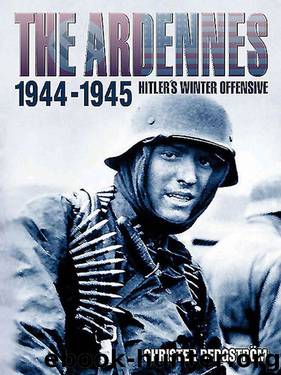The Ardennes, 1944-1945 (Hitler's Winter Offensive) by Christer Bergstrom

Author:Christer Bergstrom [Bergstrom, Christer]
Language: eng
Format: epub
Tags: HISTORY / Military / World War II, Bisac Code 1: HIS027100
ISBN: 9781612003153
Publisher: Casemate
Published: 2014-12-18T22:00:00+00:00
During their march, these Sherman tanks were exposed to hostile fire from within a spruce forest. The picture is typical of the dense forests in the area where the 2. SS-Panzer-Division operated at the end of December 1944. (NARA, US Army Signal Corps)
A German attack on 25 December from La Roche by I. Bataillon/ Panzergrenadier-Regiment 156, along with five Panzer IVs and four Panthers led by Hauptmann Werner Baumgarten-Crusis, was ambushed by Sherman tanks and tank destroyers from ‘B’ Company, 771st Tank Battalion. These were supported by fighter-bombers, whose bombs set several Panthers on fire.127 Among Baumgarten-Crusis’ tanks, four Panthers and a Panzer IV were lost.128The U.S. tank company reported the destruction of eight German tanks against a loss of two own tank destroyers.129
The Battle at Verdenne/Marche was settled mainly by four factors—the American infantry’s dogged resistance, a highly skilled leadership on the U.S. side, the German inability to bring forward the 116. Panzer-Division anyway but piecemeal, and the American air strikes. During the night of 26 December, von Waldhausen sent further elements of his division across the river to join the fight at Verdenne. Shortly afterward, twin-engine medium bombers from U.S. 9th Air Force laid La Roche in ruins, and this finally put an end to the German ability to relieve the surrounded Verdenne garrison. Meanwhile fighter-bombers from two American Fighter groups, the 36th and 48th, focused on hammering the 116. Panzer-Division.
The Americans experienced a moment of crisis when a new German force on the morning of 26 December appeared at Hotton and attacked. This was Oberst Remer’s Führer Begleit Brigade, which had been transferred to the LVIII. Panzerkorps. Remer began his attack at half past ten on the morning of 26 December. While the 105mm and 150mm howitzers of his Artillerie-Abteilung exposed the American positions west of the Ourthe to their fire, the Brigade’s Panzergrenadier-Regiment crossed the river south of Hotton, with the II. Bataillon to the left and the III. Bataillon to the right. The II. Bataillon—commanded by Major Hubert Mickley, a most experienced officer who had been awarded with the Knight’s Cross with Oak Leaves—rapidly managed to capture the small village Hampteau slightly more than a mile southeast of Hotton, on River Ourthe’s western side. Meanwhile, the III. Bataillon established positions in the Bois de Hampteau Forest, also on the river’s western side, between Hampteau and Hotton. There were no more than two miles between the Führer Begleit Brigade’s positions west of the Ourthe and Kampfgruppe Bayer at Verdenne, and Remer’s men could see black smoke rise from behind the treetops where fierce fighting was going on.
Download
This site does not store any files on its server. We only index and link to content provided by other sites. Please contact the content providers to delete copyright contents if any and email us, we'll remove relevant links or contents immediately.
| Africa | Americas |
| Arctic & Antarctica | Asia |
| Australia & Oceania | Europe |
| Middle East | Russia |
| United States | World |
| Ancient Civilizations | Military |
| Historical Study & Educational Resources |
The Rise and Fall of the Third Reich: A History of Nazi Germany by William L. Shirer(1218)
Flight by Elephant(1155)
German submarine U-1105 'Black Panther' by Aaron Stephan Hamilton(890)
Last Hope Island by Lynne Olson(810)
Unbroken: A World War II Story of Survival, Resilience, and Redemption by Hillenbrand Laura(788)
The Victors - Eisenhower and His Boys The Men of World War II by Stephen E. Ambrose(772)
0060740124.(F4) by Robert W. Walker(768)
The Guns at Last Light: The War in Western Europe, 1944-1945 by Rick Atkinson(749)
A Bridge Too Far by Cornelius Ryan(742)
War by Unknown(735)
The Hitler Options: Alternate Decisions of World War II by Kenneth Macksey(732)
The Railway Man by Eric Lomax(711)
All the Gallant Men by Donald Stratton(694)
Hitler's Armies by Chris McNab(680)
Rogue Heroes: The History of the SAS, Britain's Secret Special Forces Unit That Sabotaged the Nazis and Changed the Nature of War by Ben Macintyre(678)
Churchill's Secret War by Madhusree Mukerjee(676)
Hitler's Vikings by Jonathan Trigg(671)
A Tragedy of Democracy by Greg Robinson(649)
We Die Alone: A WWII Epic of Escape and Endurance by David Howarth & Stephen E. Ambrose(646)
